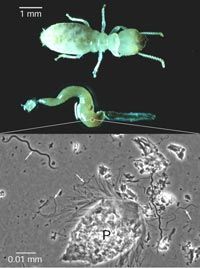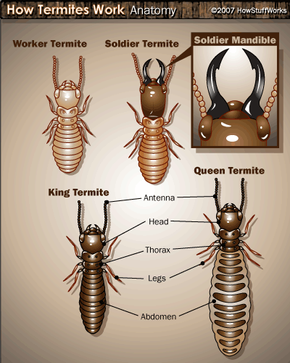Termite Anatomy
Termites are insects. They're most common in tropical environments, although they can live just about anywhere as long as the ground doesn't completely freeze in the winter. Although many people think termites resemble ants, they're more closely related to cockroaches.
All termite species are social, and termite colonies are divided into groups, or castes. Members of each caste have different jobs and different physical features:
Advertisement
- Reproductives lay eggs. Most colonies have one pair of primary reproductives -- the king and queen. In some species, secondary and tertiary reproductives assist with the egg-laying. Only the king and queen have eyes. The rest of the termites are blind and navigate using scent and moisture trails. Kings and queens are usually darker than the rest of the termites in the colony.
- Soldiers defend the nest from invaders, typically ants and termites from other colonies. In most species, soldiers have large heads and strong, pincer-like mandibles. Soldiers' heads are often darker than their bodies. Some species can secrete a toxic or sticky substance from their heads, which they use to kill or subdue intruders.
- Workers are a milky or creamy color. They have smaller, saw-toothed mandibles, which allow them to take small bites of wood and carry building materials. As their name suggests, they do most of the work in the colony. They dig tunnels, gather food and care for young. They also feed the king, queen and soldiers, who are unable to feed themselves. Workers and soldiers are sterile.
Termites' food comes from cellulose. Cellulose is a polymer, or a compound made of lots of identical molecules. It's a tough, resilient compound found in plants. Cellulose is what gives trees and shrubs their structure. The molecules that make up cellulose are glucose molecules -- as many as 3,000 of them. In other words, cellulose is made of sugar.
However, unlike the sugars glucose, sucrose and lactose, people can't digest cellulose. The human digestive system uses special proteins called enzymes to break sugary polymers down into their simple glucose components. We then use glucose as a source of energy. For example, the enzyme sucrase breaks down sucrose, and lactase breaks down lactose. Our bodies do not produce cellulase, the enzyme that breaks down cellulose.

Termites don't produce cellulase, either. Instead, they rely on microorganisms that live in a part of their digestive system called the hindgut. These organisms include bacteria and protozoans. They live in a symbiotic relationship with the termites -- neither the termites nor the microorganisms could live without the other.
The types of organisms found in the hindgut divide termites into two rough categories. Higher termites have bacteria in their gut but no protozoans, while lower termites have bacteria and protozoans. You can also categorize termites by where they live. Subterranean termites build large nests underground. Many primitive termites form colonies in the wood they are consuming.
A termite colony is essentially a multigenerational family. We'll look at termites' reproductive cycle and how it allows them to form large colonies next.
